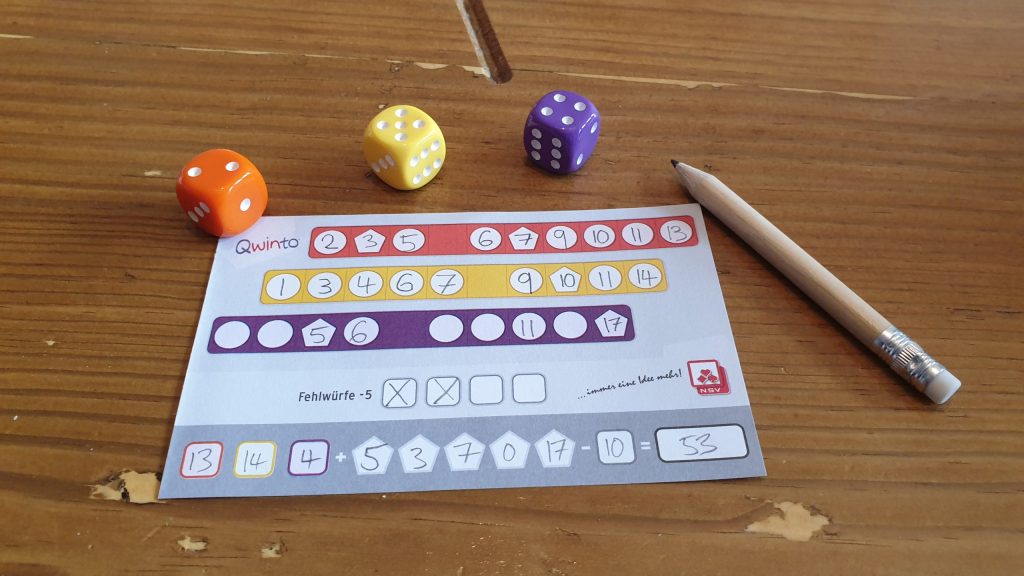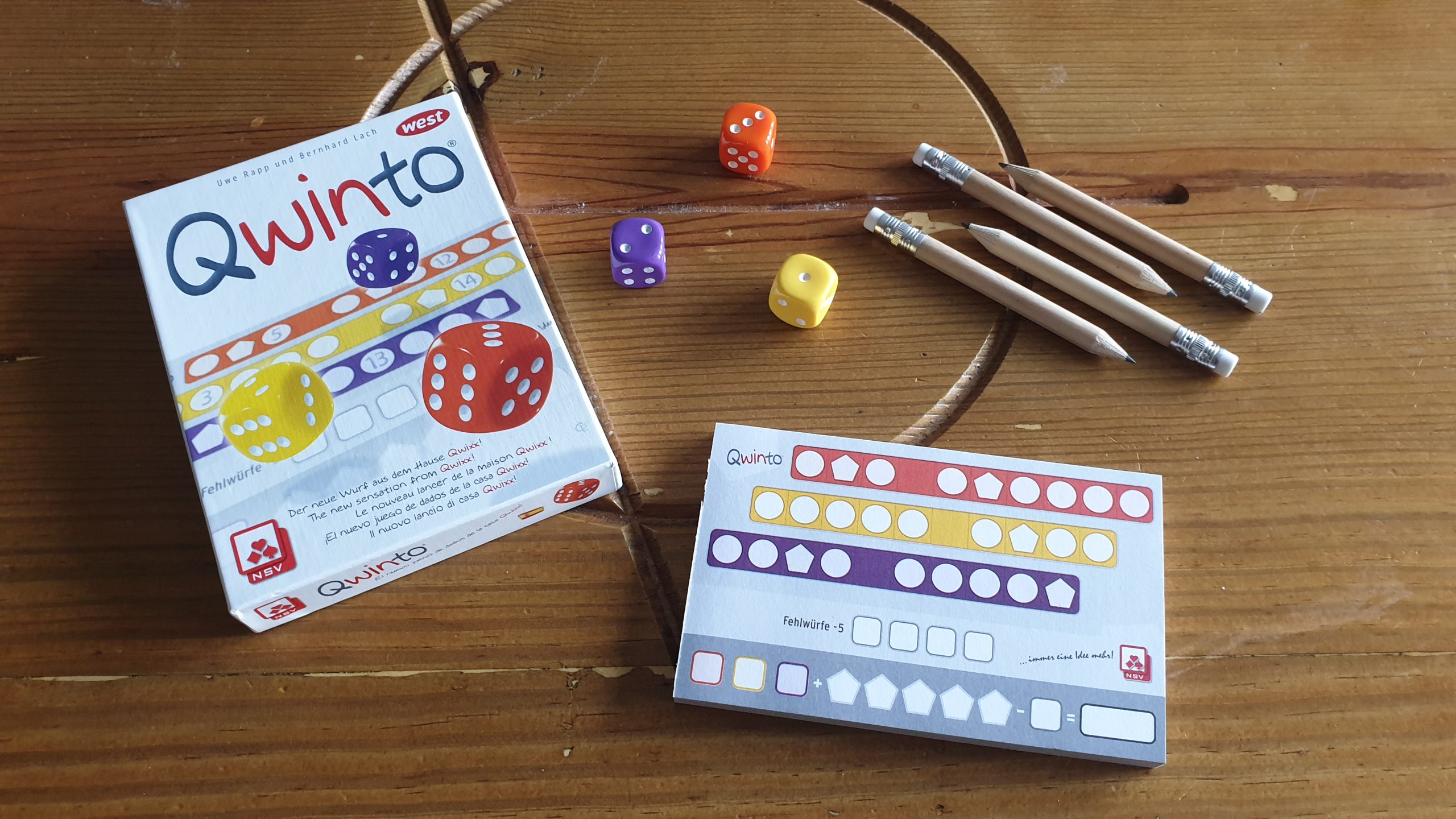Qwinto is one of the many roll and write board games from publisher Nürnberger Spielkarten Verlag. Designed by Bernhard Lach and Uwe Rapp, the game sees 2 – 6 players spend around 10 minutes rolling dice and filling in their player sheets. Using minimal components, play is simultaneous with something to do one every player’s turn. However, is that enough to stand out in the sea of the roll and write genre? Let’s find out!
Starting the game is as simple as tearing off a scoresheet for each player from the pad, giving a pencil to each player and determining whom will start. Played out over numerous turns, each turn one player will become the active player and be in charge of the dice. In Qwinto there are three dice – red, yellow and purple – which match the three coloured rows on the scoresheets.
On their turn the player will choose which of the three dice to use. Rolling the 1 – 3 dice selected the pip values are combined to give one number which all players can write onto their scoresheet. The number itself can be written into either of the coloured rows that match the colour of the dice rolled. For example, if the purple and the yellow dice are rolled the combined value can be written into either the purple row or yellow row but not the red row. The player who rolled the dice has the option to reroll the dice used once. This is important as this player almost needs to write the number onto their sheet, while all other players have the choice whether to or not.
When adding a number to their scoresheet a player may never write a duplicate number in a row or column. Numbers within a row must also increase from left to right, with 9 spaces on each of the rows. If the player that rolled cannot or does not want to use the number they receive an X mark for the failed attempt – with 4 boxes for failed attempts at the bottom of the scoresheets. All other players are free to use the number or not, without the fear of a X mark. Once all players have decided to use the number or not, the game continues clockwise with the next player rolling their choice of the dice.
The game ends when one of two conditions is met. When one player takes their fourth X mark for failed attempts, or one player completely fills two rows on their scoresheet, the game ends. Points are then earnt based upon the number of spaces filled in on the rows. A completed row scores points equal to the right most, the highest, number in the row – which could be all the way up to 18 points. If a row isn’t complete it only scores 1 point per filled in space.

There are five columns on the sheet that have spaces for all three rows. On each of these columns one space is pentagon shaped – rather than the normal circle. For each of these columns, if they are full, the player gains points equal to the number in the pentagon space. Finally, players lose 5 points for each failed attempt. Adding all this up the player with the most points wins.
There is no theme to Qwinto and nor does it try to portray an experience other than what it is. An extension of this is that the components of the game are very plain, being more fit for purpose than remotely eye catching. This applies to the score pad players use, the pencils and the dice, which roll just like any other plain but coloured six sided dice. One oddity is that the more orange-red coloured die doesn’t quite match the red used for the row on the score pad. This isn’t really forgivable for a game with so few components. Still, it doesn’t break the game with the colours still making it obvious which is which. Some roll and write games, which are paper and pencil based, don’t even come with a single pen/pencil. Nevertheless, while coming with short pencils it is a bit odd that only 4 are included, as the game plays with up to six players.
When it is a player’s turn they hold the power of the dice. Only that player can choose to re-roll, which may not sound like much but is an element that you can control. Due to this the shorter the time between turns the better, allowing players to feel that power to influence the game more frequently. At lower player counts is therefore where Qwinto shines – perhaps the reasoning for lacking those extra two pencils.
Some roll and write titles are puzzle first and game second, with Qwinto falling into the puzzle category. Players have choices, though the dice merely change the numbers written from one game to the next. Back to back games are possible because of the short play time, though they often feel similar. The puzzle there to crack is unique each time. Alas, it never drastically ventures far from the risk of putting a high or low number too close to the middle of a row, or chancing your luck on rolling a needed number.
Coming in such a tiny box Qwinto is ideal for travelling with. While now isn’t a time to travel, the box, which isn’t much bigger than a deck of cards, can easily fit into a backpack or even a large pocket. The table space the game needs is also very limited, allowing it to be played on the fold down tables on a train. The short game time is also ideal for playing a couple of rounds in an evening away, when you don’t want an experience that’ll boggle your brain or take up too much time.
In a surprising way there are ample choices provided to players. Despite them only being whether to roll 1 – 3 dice and where to write a number, the choices do seem to matter. Qwinto certainly doesn’t rely on looks or stellar components, as the look of the game does little to attract those outside of roll & write addicts. Thankfully, within 10 minutes it can scratch the puzzle itch and be packed away. That is all it aims to be – nothing more, nothing less, than a solid little game.
(Editor’s Note: Qwinto was provided to us by Coiledspring Games for the review.)

